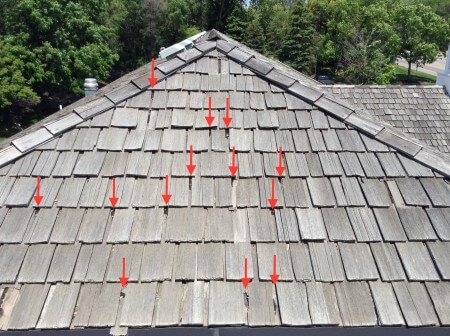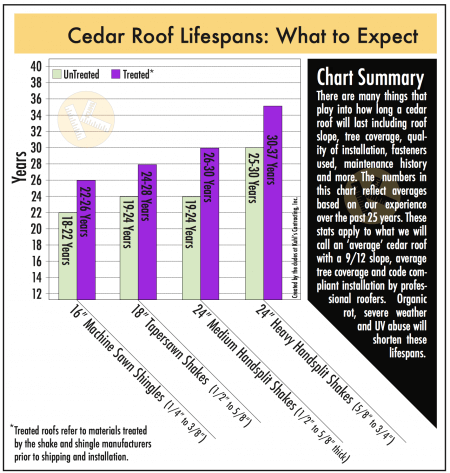This is a guest blog post by Steve Kuhl, of Kuhl’s Contracting.
In the past 25 years I’ve inspected somewhere in the neighborhood of 9,000 cedar roofs in the Minneapolis area. In that time I’ve seen just about every conceivable type of wood roof and the variables that factor into how long they last. This post discusses the basic components of a cedar roof, the different material options available and what sort of lifespan one can realistically expect from each.
First things first. The point of all of the wood on a cedar roof system is simple. It’s there to protect the underlayment (i.e., tar paper or felt). The wood is not there to waterproof the structure below, despite what most homeowners believe. Water is, in fact, able to get between and under shakes and shingles in many circumstances such as wind-driven rain. The tar paper is what keeps a home dry. The purpose of the cedar roofing is to protect the underlayment from the harsh elements, specifically wind, rot and the sun. Very few of the roofs I’ve inspected over the years have failed because the wood itself is damaged. Failure—that is to say, leaking—occurs when the underlayment is compromised. The most common form of damaged underlayment is caused by UV damage. Here is a link to an interesting case study on my web site that discusses this topic: What Really Kills Most Cedar Shake Roofs.

Approximately 90% of the cedar roofs in the Twin Cities are hand-split cedar shakes and 10% are cedar shingles. The difference between medium and heavy hand-split shakes is the thickness on the butt edge, with mediums averaging 1/2”-3/4” and heavies averaging 3/4”-1”. Cedar shingles have an average thickness of 5/16”. For the sake of simplicity, I’ve included taper sawn shakes under the shingle category because they are essentially just a cedar shingle on steroids (longer and thicker). Tapersawn shakes, which range in thickness from between 1/2”-3/4”, are becoming more and more common but still represent a very small segment of the market. For more details on this topic, click the following link for a comparison of cedar roofs in Minneapolis.
There are two very basic identifying characteristics that tell us if we are looking at a cedar shingle versus a cedar shake. Again, for the sake of keeping this discussion simple, shakes have split faces (appear rough and irregular) and shingles have sawn faces (appear smooth). The second identifier is the exposure, or course spacing of the material. Shake roofs typically have a 10” exposure and shingle roofs have a 5” exposure. Taper sawn shakes confuse everyone because they can have exposures from 5” to 7” to 10”.
My experience with cedar roofs has given me a unique perspective on how long cedar roofs should last in our climate because I get to inspect roofs that range from new to 30 years old, or more. I’ve long since ignored the manufacturer’s claims about cedar roof lifespans because I’ve been a first person witness to what actually occurs here in Minnesota over the arc of time. It’s not uncommon for me to inspect the same roof over 10 or 15 years for multiple home owners of the same home, giving me a long-term perspective on how they age.
Based on my experience, here are what Minnesota homeowners can expect relative to the longevity of the cedar roofs on their homes, assuming there is no history of maintenance. Cedar shingles will last 18-22 years, medium hand-split roofs will last 19-24 years, heavy hand-split roofs will last 25-30 years. Variables such as the tree coverage, the amount of sun that hits the roof and the quality of the labor and materials used for the install all factor significantly into how long a cedar roof will last. Probably the most important variable, however, is the maintenance history of the roof. If it has been maintained through occasional repairs, cleaning and wood preservation, the lifespan can be increased significantly. The process of cedar roof maintenance, or restoration, can range from a very good investment to a total waste of money, depending on the condition of the roof being considered and the quality and integrity of the company employed to do that work. Put simply, many roofs are not worth taking care of in any way while others can benefit greatly from some TLC. I will describe the cedar roof restoration process and the parameters for defining what roofs are good candidates in an upcoming blog.

Cedar roofs continue to be a great choice for the discerning home owner who wants a roof that has a great balance between affordability and architectural character. There is nothing else on the market that can provide as much beauty and performance as a cedar roof, and because the materials are harvested from managed forests and can be fully recycled upon disposal, cedar also is arguably one of the greenest choices around. In general, it remains the best choice for mid to high value homes when aesthetics are a primary concern.
Author: Steve Kuhl, Kuhl’s Contracting
